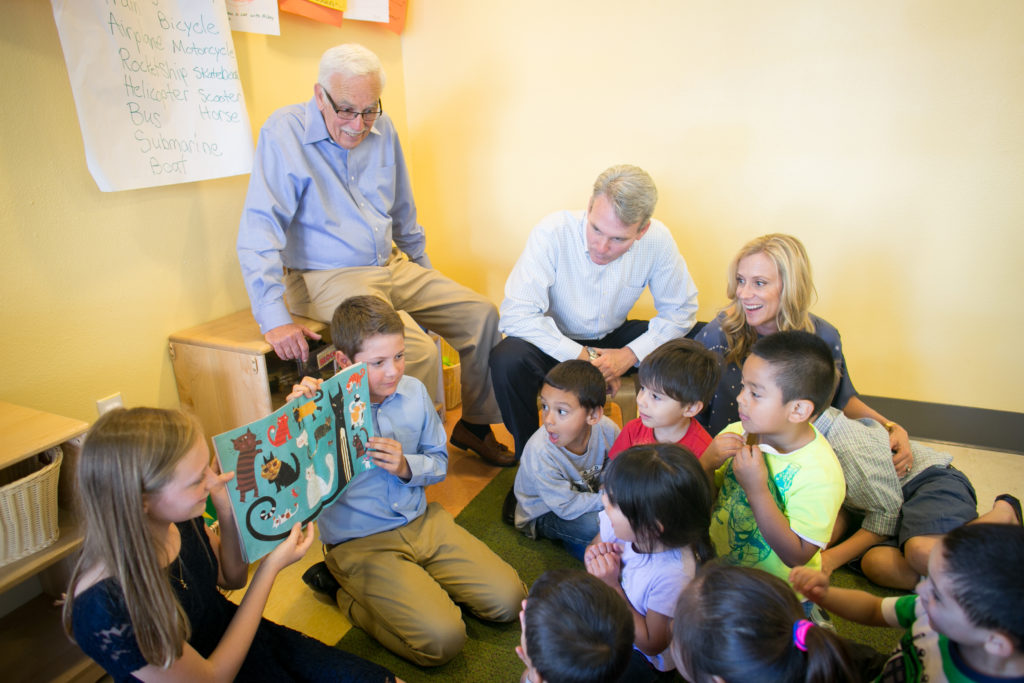
Engaging Seniors in National
Service
Engaging Seniors in National
Service
A California foundation creates opportunities for seniors to serve and mentor upcoming generations.
Young people in our country, especially those who are of color and living in low-income communities, face great challenges in their efforts to create a better tomorrow for themselves. In Los Angeles, where The Eisner Foundation does most of our work, the high school dropout rate is 19%, nearly one third of kids live below the poverty line, and 30,000 children are in foster care. The numbers may not be as stark in other parts of the country, but no matter where you reside, I guarantee that the young people in your community face an uphill battle to success.
One way to level the playing field for at-risk kids is to provide them with a massive infusion of volunteer or low-paid mentors, teachers, tutors, and advocates, primarily through an expansion of some sort of national service program. One such proposal is the Franklin Project, an idea conceived at The Aspen Institute by General Stanley McChrystal, former commander of U.S. forces in Afghanistan, who urged a massive expansion of national service for young people.
35 million older Americans are looking for opportunities to serve their country.
There is obviously much to be said for service by young people, and for middle-aged and older people standing up for that idea, especially in the context of the proposed unprecedented funding cuts to AmeriCorps. (I personally benefitted from service shortly after college, when I was a Teach For America teacher in North Carolina for two years. I like to think my students also benefited from my service.)
But amid the enthusiasm (and funding) for service by young people, it’s also time for our nation’s senior citizens to challenge their peers, and themselves, to step forward to serve as well. And it’s time to challenge policy makers, philanthropies, and the corporate sector to make those opportunities for senior national service more widely available.
Why now? It’s no secret that there is a population explosion of people entering the second half of life, and doing so with unprecedented skills, education, and vitality. There is also a deep desire to contribute that human and social capital to help solve pressing problems faced by the country. Some 35 million of our nation’s citizens over 50 say they want to launch an encore career, a second act focused on the greater good.

Courtesy of The Eisner Foundation
With a new, older President in office, now is a great time to step back to think about the prospects of later life and the aging society. It is also a fabulous opportunity to celebrate the Foster Grandparent Program, a little-known and under-appreciated triumph of the War on Poverty, and one that enables older individuals of modest means to work one-on-one with disadvantaged or disabled children and youth. We’ve supported their work in Southern California, and seen the benefits that can be created, not only for the kids that receive the services, but for the seniors who gain purpose and subsequent improved health outcomes for themselves.
The idea of senior national service is not just due to demographics or new administrations: when a set of leading analysts have assessed the potential of national service, they have recognized that engaging the older population may be the most promising idea of all in this arena. For example, some twenty years ago Richard Danzig, who went on to become Secretary of the Navy, and Peter Szanton of the Kennedy School looked at the promise and prospects of national service for the Ford Foundation, which resulted in the first significant book on the subject. Their conclusion was thus: “Older people have more to give and more to gain from national service than any other group.”
We’ve seen these benefits in powerful form through our annual Eisner Prize for the best intergenerational organization in the nation. One of the first winners was Experience Corps, now part of AARP, which empowers adults over 50 to tutor young children reading below grade level. Research by Washington University in St. Louis and by Johns Hopkins Medical School in Baltimore both demonstrate a trifecta of benefits associated with the program: for Experience Corps members themselves; for reading by low income kids by grade three; and for the schools where they are placed.
Isn’t it time for a policy initiative that realizes this solution waiting to happen? And if we do take on this rising opportunity, let’s do so in a way that not only enables older people to bring together their experience and idealism, but that enables them to serve side by side, shoulder to shoulder, with young people who have the same aspiration to create a better world. In this way, we create another trifecta of recipients—the older folks giving back, the young adults doing the same, and the children who should reap the benefits of their mutual mentoring.
This is already happening on small scales nationwide. Organically, there are now more than 300 Teach For America teachers over 50. Jumpstart is recruiting seniors to work in low income preschools. The Boys and Girls Club of the L.A. Harbor has created a senior corps to help low-income kids get into colleges through tutoring, mentoring and assistance navigating educational and financial resources. And by design, The Eisner Foundation is partnering with Encore.org to specifically promote national service for seniors through their Generation to Generation campaign.
Intergenerational solutions like these can help solve our nation’s greatest challenges. The time is now for national service by our older Americans.
Trent Stamp is CEO of the Eisner Foundation.
Project
Senior National Service
Philanthropy
The Eisner Foundation


